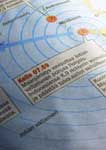Environmental Risk
Environmental problems threaten the long-term future of humankind
The consequences of a growing population, over-exploitation of natural resources, pollution, waste and the threat of climate change and other natural catastrophes have all combined to create extreme environmental stress and biodiversity loss, with no knowledge where the tipping points might be.
We have identified several key issues central to understanding environmental risk, namely:
- How to achieve sustainable blueprint for both the developed and emerging world?
- How to internalise economic externalities and put a price on environmental exploitation and pollution?
- How to achieve prosperity without greater consumption?
Anticipating and understanding environmental risk is critical for any organisation with medium to long term future plans. Environmental risks and the need for sustainable development are likely to become issues high on the agenda of every CEO of the future.
An example of our work
Tsunami project on Uninsured Losses of Natural Catastrophic Events
What are the direct and indirect losses stemming from natural catastrophes? Who bears them? How do public policies and institutional arrangements vary globally?
Linnerooth-Bayer, J., S. Quiano, R. Löfstedt and S. Elahi (2000) The Uninsured Losses of Natural Catastrophic Events, Seven Case Studies of Earthquake and Flood Disasters. Summary Report. IIASA, Laxenburg, Austria. Download summary report
This project was funded by the TSUNAMI Initiative, jointly funded by the Insurance Division of the UK Treasury and a consortium of composite insurers, brokers and Lloyd's managing agencies. It was undertaken by the International Institute of Applied Systems Analysis and the Centre for Environmental Strategy, University of Surrey, UK.
Natural catastrophes
Natural catastrophes are extreme environmental events, often with sudden onset. They fall into four categories, namely: geophysical events, such as earthquakes and volcanos, meteorological events, such as tropical storms, winter storms, hail, and tornados; hydrological events such as storm surges, river flooding and landslides, and climatological events such as freeze, wildland fires or droughts. Over the last fifty years there has been a nine-fold rise in losses from these natural catastrophes. Global population explosion, land use changes, especially urbanisation and deforestation, the increased concentration of people and economic value located in vulnerable areas are all contributing to the increasing scale of these losses.
Large urban areas are particularly vulnerable to natural hazards, as many of them are sited in high-risk areas, and their shanty towns have almost no preparedness for disasters. There are now over 20 'megacities', with populations in excess of 10 million inhabitants, of which only four are in the developed world. Urbanisation projections are that by 2025, approximately 5 billion people (60% of the global population) will be living in cities, exacerbating this phenomenon. In addition to these human factors, weather patterns due to climate change are becoming more variable and extreme, thereby increasing risks. All these factors are contributing to the increased vulnerability of modern society to natural hazards.
Losses from natural catastrophes
The impact of these losses is great and there are very few reliable estimates. In the developing world the human losses from natural hazards have increased dramatically and every year, tens of thousands of people die as a result of natural hazards. Most of these global fatalities are in Asia. For example, in 2008, 85,000 were killed (and 54,000 still missing) by a cyclone of Myanmar, and 70,000 lost their lives (and 18,000 still missing) in an earthquake in Sichuan, China.
Losses from natural hazards have also been risking steadily. In 2008 alone losses from 750 natural hazards totalled USD 200 billion, almost three times that of the previous year. Insured losses amounted to US$ 45bn, 50% higher than the previous year. The global pattern of these losses is far from even. Every year, Asia accounts for almost half the financial losses, but insured losses are seldom more than 10%. In contrast, global losses in North America the losses are generally between 30-40% of the total global losses, yet it accounts for almost half of the insured losses. Financial, insured and human losses are negligible in Australia, Africa and South America.
In addition to direct economic losses which can be estimated, there are many indirect losses on societies impacted. These range from the psychological and social impacts of loss on individuals and community structures, to the permanent changes wrought by such crises. In some cases, the influx of aid can stimulate the local economy, but in many cases the reverse holds true. For example, Kobe never managed to regain its pre-eminence as a global port after the Kobe earthquake.
Bearing the losses
There is comparatively little international disaster aid and international loss sharing at the global level. Throughout the world, governments incur huge expenses in compensating uninsured citizens for their losses from natural disasters and in repairing public infrastructure damage, although the role of government assistance varies considerably across countries.
This project examined seven flood and earthquake disasters, namely the 1993 USA Midwest floods; the 1993 and 1995 German Rhine river floods; the 1997 Polish flood; the 1998 UK Easter flood; the 1994 California Northridge earthquake; the 1995 Japanese Kobe Earthquake; and the 1997 Italian Umbria-Marche earthquake. Flood and earthquake disasters were selected for study because these hazards have accounted for almost half of the catastrophes and 65 percent of the economic losses during the past five decades. While the number of catastrophes and losses are fairly evenly distributed, fatalities have been considerably higher with regard to floods, and the insured losses higher with regard to earthquakes. The estimated direct losses from the seven selected disasters were USD 176 billion, almost one-third of the total estimated global natural catastrophe of the decade. These cases also provide a useful comparison of national public-private systems for mitigating and sharing disaster losses.
The case studies indicated that at one extreme, Italy has practically no insurance for earthquake disasters and substantial statutory state aid and, at the other extreme, the UK offers practically no state aid and substantial insurance cover for flood risks. Between these extremes, there is a mix of public assistance and private insurance. The vulnerability of a country to financial losses depends on its economic strength, its mitigation efforts and its loss-transfer/loss-recovery institutions and these vary remarkably. For example, the USD 3.7 million Polish flood represented a higher percentage of the country's GDP (2.8%) than did the USD 100 billion Kobe earthquake (2.2%).
Besides communal loss sharing among families, churches and communities, the main forms of loss sharing are state assistance and private insurance. The mix of these state and market institutions will depend on public values towards individual responsibility and social solidarity. Loss-transfer institutions are also important because they can influence the reduction of the losses, for example, private insurance premiums and state compensation can be tied to risk-mitigation measures. With the unprecedented increase in the losses from natural disasters over the globe, innovative measures and institutions for reducing these losses and for sharing them among those who are able to absorb them are urgently needed.
The role of insurance
Insurance is a way of spreading risk across society. Using the 'law of large numbers' everyone within a given community can pay a small premium and pool the diverse range of risks they face. Insurers can also protect themselves against the risks of extreme losses by means of reinsurance. However, when risks are inevitable or their probability cannot be calculated, they become uninsurable and other forms of counter measures have to be taken to reduce or spread the risk.
The insurance model is dependent on the financial capacity of the insurance industry and its ability to deal with the related claims. In the good years where losses are low, insurers are able to build up reserves to meet their obligations, but as the frequency and size of claims increase the loss potential can move beyond the capacity of the insurance industry. There are also two information asymmetry issues that impact the ability of insurers to calculate probability. Adverse selection means that those who are high risk are those most likely to take out insurance policies, because insurers cannot effectively discriminate against them, either due to lack of information or legal restraints. Limiting coverage and/or raising premiums are ways to try to counteract adverse selection. Moral hazard means that those most at risk are often insulated from the consequences of their actions when societal compensation schemes are in place, so that they have little incentive to mitigate the risk or better adapt to their risky environment.
The perception that the government will compensate uninsured losses, for example, in Italy, Japan, Poland and the US reduces insurability of natural catastrophes, particularly when high risks and correspondingly high premiums keep demand in check, as is the case in both Japan and California. A successful measure to increase demand is to bundle catastrophic insurance with property insurance as in the UK, but increasing losses and growing competition are making this model harder to sell. None of the countries studied had mandatory catastrophic insurance.
The supply of natural disaster insurance is also constrained by the willingness of insurers to enter high-risk markets where information on the risks is incomplete, but risk mapping and computer technologies for estimating risks are improving insurability in many countries, for example, in Poland, Germany, the US and Italy. Another important factor in encouraging insurance supply in high-risk countries is government reinsurance, as is the case in Japan and the US. The emergence of new risk-transfer instruments, such as catastrophe bonds, may also improve reinsurance opportunities for insurers operating in these high-risk markets.
Risk reduction
In countries across the world, societal responses to natural hazards range from nothing to complete cover. This cover can be provided by governments or privately, or a mix of both. Clearly, insurance and reinsurance play a much smaller role than national governments in absorbing losses, but these institutions are becoming increasingly important in transferring global risks. Even in OECD countries, insured losses are only in the range of 1 to 40% of the direct overall losses (including private and public-sector losses).
As governments become more concerned with fiscal austerity, there is increasing pressure to shift the public-private mix to more responsibility to the private market. Many point to the advantages of individual responsibility in promoting incentives for loss reduction, for example, in making it more costly to locate capital in high-risk areas. These incentives could be enhanced by directly linking insurance premiums to private mitigation measures. Clearly, all countries could improve on the public measures as well as private incentives to reduce losses.
Summary
The risks of natural catastrophes will continue to rise, fuelled by demographic and environmental pressures. In the developing world, the greatest risks are human losses, while in the developed world individuals will increasingly be expected to bear the risks themselves. How nations share the costs of recovery, and how these costs can be transferred outside of national borders, is therefore of critical importance to the resilience of the country.







